Platypus House

Beez Neez now Chy Whella
Big Bear and Pepe Millard
Wed 20 Jan 2016 23:37
|
Platypus House
 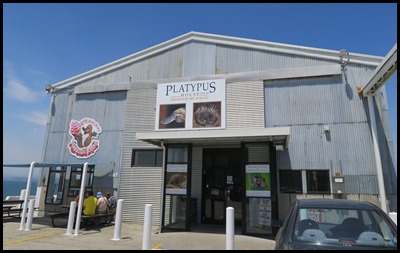  We left
Beaconsfield Mine and headed to Beauty Point, a quick bite to eat in Mabel and
then we took the short walk from the car park to the converted warehouses on the
pier that are now home to Platypus House on the right and Seahorse World next door,
on the left. We had time to look around the Education Room before Tracy, our
guide took us in to see our first platypuses.
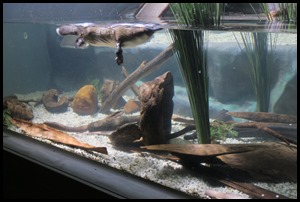 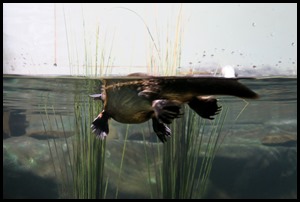  Wow. We walked into a darkened room and
saw three tanks. In the first was Jupiter, about
eight years old and current beau of Dawn. He weighs three kilograms and is
described as big bodied with bright eyes. His favourite food is fat earth worms,
his favourite pastime is showing off and wagging his tail. We watched as he swam
up and down his tank, miss a couple of yabbies bimbling about of the floor of
his tank, hold his breath and scruff under the pieces of wood and eventually
walk up his plank to go to his day bed which also connects to the mating pool
‘out back’. We were transfixed. Platypuses swim only using their front feet –
his rear ones just dangled and occasionally steered, his tail looked like a
course brush and his beak looked like badly shaped play-doh shoved on
willy-nilly.
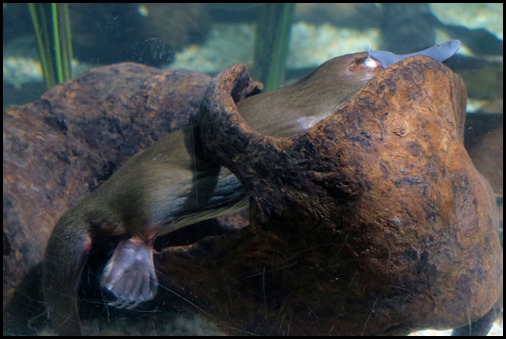 In the next tank was Dawn, sound asleep. These creatures can take a deep breath
and go underwater for about ten minutes, slowing their heart rate as they
settle. Eyes closed they look so strange. We both thought they would be bigger,
this just added to their cuteness.
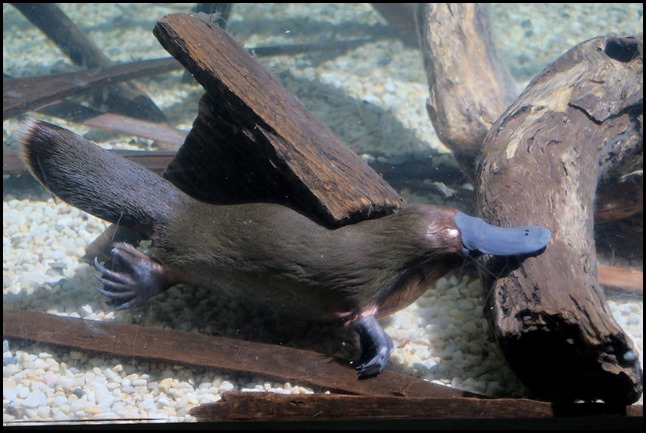 In the third and final tank was Freya, also fast asleep but constantly being bumped into by
Poppy. The girls, like Jupiter can access their day bunk or go through to the
breeding tank, should they fancy.
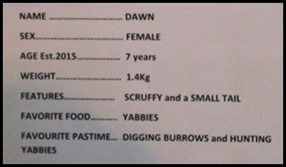 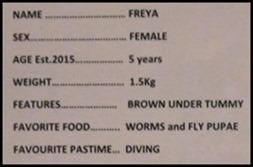  The vitals of the
girls.
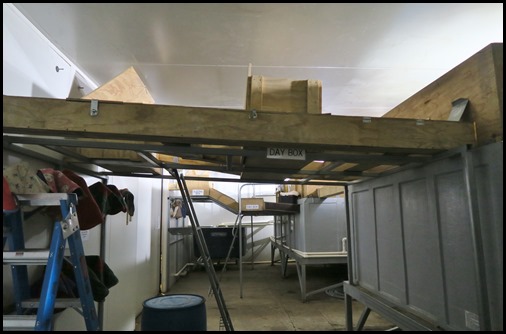 Time to move on, in the next room we could
see the wooden tunnels at the backs of the tanks. The
Platypuses can bimble through, or stop for a nap in their day boxes. This end is
Jupiter’s, the far end is the girls.
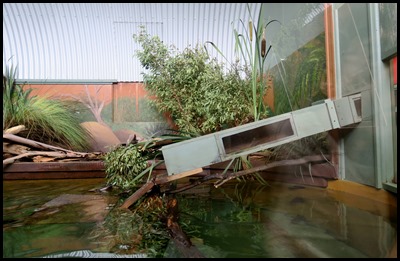 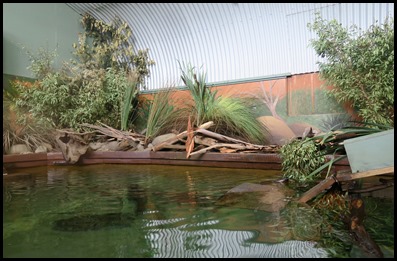 In the farthest room was the breeding tank. No one popped in during our visit but it
looked very nice.
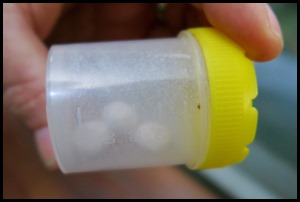 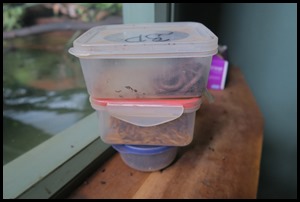  Tracy showed us the size of their eggs – about the size of a Mint Imperial and their
various snacks of earth worm, maggots and other tasty
titbits. When we returned to the tank room Jupiter was off
up his slope, sadly, the camera focussed on the water drops but it’s in
to give an idea.
 A final look at the girls gave us a chance
to look up close to Dawn’s tail, where Platypuses store their fat. In the information room we would
get to feel just how course the tail is and how sharp the claws are, ideally
built for swimming and scruffing about.
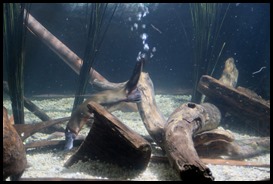  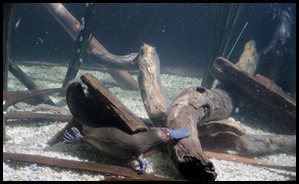 As the animal dives a trail of bubbles follows as the air works its way through
their thick fur.
The platypus is Australia’s only aquatic
freshwater mammal, apart from the water rat, Hydromys chrysogater.
Platypuses are found in eastern Australia including all of Tasmania and King
Island. Their most northerly distribution is round Cooktown in Queensland and
west to Renmark in South Australia. Their
habitats are banks of streams and lakes: the animal feeding in the water for the
most part. In the winter they do not hibernate and will swim under ice to find
food; having air holes in the ice so they can pop up to take in a breath. Their
nostrils are slightly raised so the animal can obtain oxygen while the rest of
the body remains under water.
 The nose end is
just a comedy. The bill is rubbery and leathery at the same time, and is not
‘fitted’ at the front edges.
 Sadly, it was time to leave these amazing
little creatures to visit with the Echidnas. They were of course completely
unbothered and slept through our
leaving.
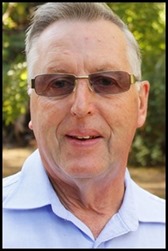 After our equally
fascinating look up close and personal with three friendly Echidnas we went back
to read the information and then to watch a video about a couple of researchers
who managed to get a fibre-optic camera into a nest to watch the feeding and
development of a couple of puggles.
Platypus House was founded in 2002 by
Professor Nigel Forteath and Nick Jones. There are
only three Monotremes or egg-laying mammals in the world, namely the Platypus
and the short and long beaked Echidnas. The Platypus and short beaked Echidna
are found only in Australia.
Platypus House was built as an
educational experience to enhance public awareness of these unique and shy
animals. It is hoped that through public awareness and a better understanding of
the animals that we will see the urgency in wanting to save their environment
and in turn the species themselves. Australia is the driest continent in the
world and the consequences of ‘climate change’ on these unique creatures may be
dire.
Early climate change probably was
responsible for the extinction of Platypuses in Western Australia and the
Northern Territory. Platypuses were hunted to extinction in South Australia in
the last century and Tasmanian Platypuses have and continue to be threatened by
a fungal disease, Mucor amphibiorum, which has been responsible for a great many
mortalities.
In 2004 Professor Forteath was largely
instrumental in obtaining a significant grant for a major survey of the
Platypuses of Tasmania aimed at monitoring the spread of Mucor amphibiorum in
Platypuses throughout Tasmania.
Dr Tom Grant, in his excellent book on
Platypuses, lists several other very real threat to Platypuses such as drought,
organic pollution, salinity, introduced predators, introduced species [such as
frogs carrying the deadly fungus M. amphibiorium into Tasmania], and the
construction of deep water dams. Every day wetlands in Australia are threatened
by human development and of course these ecosystems form essential habitats for
the aquatic Platypus. The loss of waterways, whether through drought or human
activities, not only threaten the Platypus directly through loss of breeding
sites but also result in the reduction of invertebrates which are the food
of these unique creatures.
Bushfires and lack of bush diversity
also affect the lives of Echidnas and Platypuses. The former kill and maim
Echidnas and destroy their food supplies; early season fires kill their young.
Mono-cultures of Eucalypts seldom provide the diversity of invertebrates
required in the diet of Echidnas and at the same time may significantly reduce
the number of aquatic invertebrates in creeks due to a lack of mixed detritus
falling into the water which in turn will affect Platypus
numbers.
Platypus House is one of the few
places in the world where patrons can see live platypuses and learn both about
their life history and the threats they face in Australia’s changing
environment. Few people know about the biology of the Platypus and Echidna and
Platypus House is committed to a truly educational experience.
 The Platypus, drawn by
J.W. Lewin in 1810. After the original watercolour in the Mitchell
Library, Sydney
 The monotremes are mammals that are
characterised by: laying eggs,
reptile-like front limbs [pectoral girdles] which extend outwards [laterally]; a
common urinary reproductive [urogenital] and rectal opening called a cloaca.
Cloaca comes from the Roman Goddess of Sewers viz: Cloacina; a penis that
carries spermatazoa only; unfused pelvic bones; a spur near the ankle in males
[with a poison gland in male platypuses]; mammary glands but no nipples, paired
ovaries [but only left ovary functional in platypus] undescended testes and no
whiskers [vibrissae].
There are two families of monotremes
left in the world namely the Ornithorhynchidae [platypus] – birdlike
snout and Tachyglossidae [echidna]. There is only one species of platypus
[Ornithorhynchus anatinus – duck like] but two species of echidna – the
Australian short-beaked echidna and the Guinean long-beaked
echidna.
It should be noted that Tasmanian
platypuses may be distinguished from those on the mainland and King Island by
differences in DNA.
Fossil remains of monotremes: opalised
jaw bone in Lightning Ridge N.S.W. - 150 million years old. Bone fragments in
lake beds in Queensland - 15 million years old. Skull, Riversleigh in Queensland
– 15 million years old. Tooth in Patagonia – 62 million years old.
Monotremes may well have lived
throughout the great land mass called Gondwanaland.
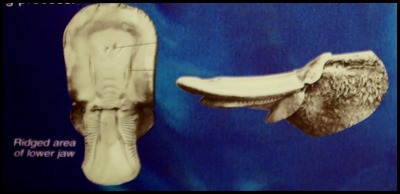 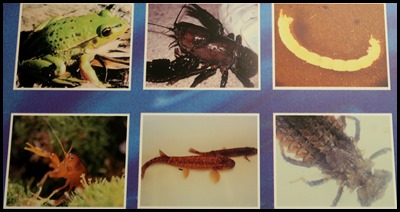 Platypuses feed during the day in the
colder months in Tasmania but during the summer, the evenings and early mornings
are favoured. It is not unusual for foraging to last up to 12 hours a day. It is
often said that platypuses eat up to half their body weight each day. This may
be true following periods of reduced food supplies e.g. flood, mass emergence of
aquatic insects, but well fed animals thrive on 15% of their body weight per
day.
Babies have one premolar and two
molars on either side of their upper jaw and two molars on either side of the
lower jaw. Juveniles lose their teeth soon after leaving the nest. The teeth are
replaced by horny pads which are renewed since chewing wears them
down.
Platypuses use touch stimuli and
electrical fields to find their food. Underwater they close their eyes, ears and
nostrils. The bill and the frontal shield are covered in minute pits which open
into sensory organs. From these organs nerves transmit messages to the brain,
especially the cerebral cortex. Indeed the bill is the platypus’ main source of
information about the outside world. Many prey species give off enough
electricity to inform the platypus of their presence and encourage a feeding
response by the latter. Other prey items are found using tactile stimuli. Not
surprisingly, there is considerable overlap between the two means of
detection.
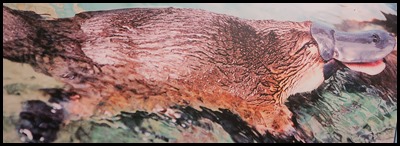 Chewing: Platypuses catch most of
their food on the lake or river bottom, sieving through the mud, sand and
gravel. Small food items are stored in cheek pouches and brought to the surface
where they are chewed and sifted. Large prey items such as yabbies take
considerable time to chew and grind and perhaps the strange ridged serrations on
the lower jaw help sort the mashed pieces of food or simply serve to grip the
food. Some biologists have suggested the pouches store grit to assist the
grinding process but this is not proven. Certainly food may be regurgitated or
ground several times. The tongue is rough and two tooth-like projections which
may further enhance the grinding process.
  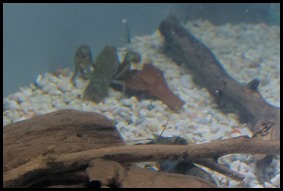 The food or diet of the platypuses
mainly consists of aquatic insect larvae / nymphs, aquatic worms and earthworms,
shrimps and yabbies, frogs and small fish. In
Tasmania salmonid eggs provide a welcome change to their diet. Tasmania is the
world’s hotspot of freshwater crayfish diversity. Many of our species are found
nowhere else on Earth, and some have very restricted distributions within
Tasmania.
The Cherax Destructor Yabby is a
native to most of mainland Australia but is an introduced species to Tasmania
and have infested some farm dams in the State. Yabbies can occur in a wide
variety of natural and artificial habitats including creeks, rivers, lakes, farm
dams and irrigation channels.
Cherax destructor has the potential to
carry disease and parasites harmful to our native crayfish and can degrade the
natural habitats of native species by destroying native aquatic vegetation and
increasing water turbidity. Their burrowing activity can also damage farm dam
walls and irrigation channels. The introduced yabby has been declared a
‘controlled fish’ Inland Fisheries Act [1995].
The Cherax destructor has a rapid
growth rate reaching maturity in as little as four months. Mature females devote
most of their energy into reproduction and can spawn prolifically up to three
times in a breeding season.
The yabbie has the ability to out
breed the Tasmanian yabbies and destroy the habitat for them and other native
species.
The Cherax destructor has been known
to completely take over small catchment areas causing turbidity and degradation
of their environment. Waters that have held strong populations of frogs,
tadpoles and aquatic insect and birds have become quite barren to anything else
other than the Cherax destructor yabby.....
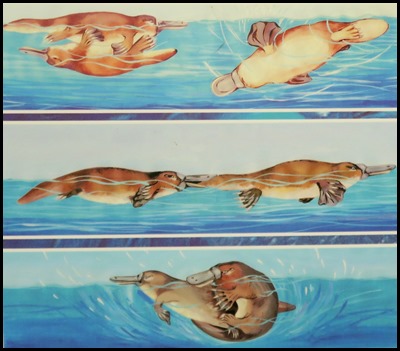 The platypus and the echidna are the
only surviving egg-laying mammals. The female platypus lays her eggs [one or
two] in a carefully constructed nest underground, while the echidna lay their
single egg into a crude, seasonally developed pouch. Once hatched, the babies –
known as puggles, feed on mother’s milk. The female platypus care for their
puggles in the burrow but the echidna only digs a burrow once the baby is too
prickly to carry.
Platypuses in the tropics tend to mate
in July but in Tasmania mating occurs in late September or October. Both types
of monotreme release a pungent odour during the mating season. Platypuses may
not mate every year and females probably do not mature until the age of five or
six years of age. Males mature at two years of age. Life expectancy can be
eighteen years.
  Burrow temperatures are maintained
close to 18 degrees centigrade throughout the year. Platypuses are covered in
fur, in fact there are two layers of fur, the under fur is very fine and traps
an insulating layer of air. The flat bladed guard hair is longer and helps keep
the air bubble in place and aids insulation.
The hair on the tail is quite course
and probably plays no role in insulation. The fur dries very quickly out of
water. Moulting of the long guard hairs takes place in late
spring.
Platypuses like to keep their bodies
at about thirty two degrees Centigrade. They hate the heat and hide in their
burrows in hot weather.
 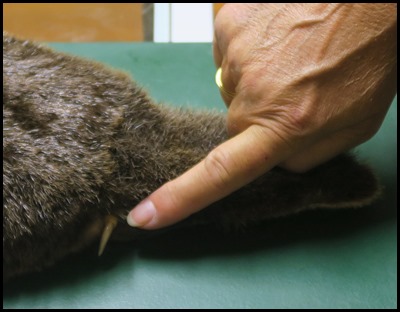 The male platypus has a spur on both
ankles attached to a small bone which articulates. When angry or threatened the
spur is moved at right angles to the leg and is ready to be kicked into its
victim and venom is released. The venom is a cocktail of toxins, several of
which act directly on pain receptor cells. Platypus venom will kill other
platypuses, cats and dogs.
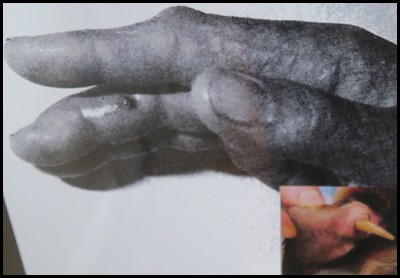 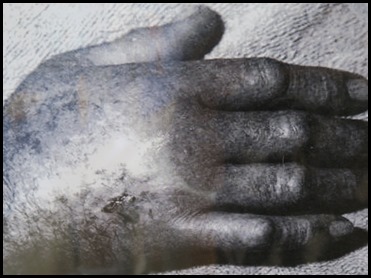 There is no anti-venom against
platypus poison and humans have experienced excruciating pain but it is not
lethal.
What makes Platypus venom unique ???
There are only two mammalian venoms known in the world. The effect it has on
humans is profound. Victim’s experience intense pain and immediate swelling of
the tissue around the spur wound. Swelling and prolonged pain normally lasts for
up to three months, sometimes longer. Neither morphine nor any other pain killer
has any effect on the pain. Anaesthetising the affected area will help but the
patient will still experience intense swelling and throbbing. Study of the
effects of platypus venom and why it is immune to pain killers may well lead to
a better understanding of how human pain signalling works.
Both male and female growl when
threatened, however females communicate with their young in the nest by growl
sounds also.
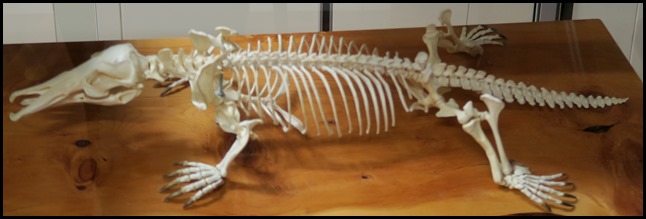 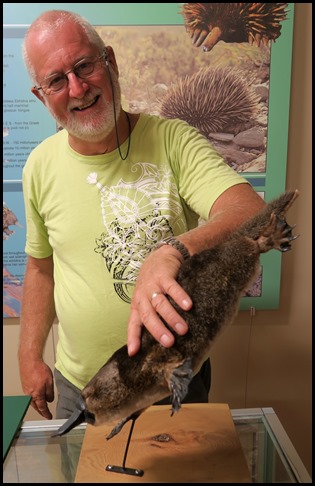 In 1799 the British Museum received its
first Platypus and didn’t really know what to say about it......Our first
experience with the platypus – beak like a duck, fur bodied like a bear, bristly
tailed like a beaver, egg-laying like a bird, eats with grinding plates, can
reduce heart rate and produce venom like a snake.......... too amazing not to
protect. Time for happy pictures.
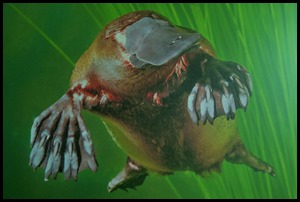  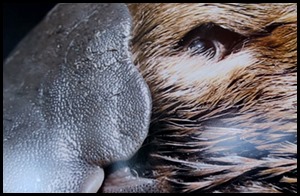 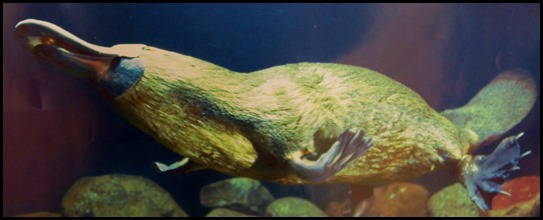 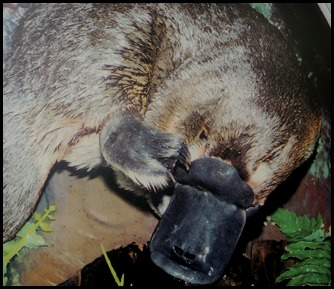 ALL IN ALL SUCH A UNIQUE
CREATURE
THE WEIRDEST ANIMAL BUT SO VERY
CUTE |